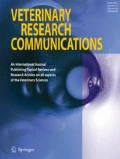Abstract
Anthropogenic activities, predation, and diseases have contributed to a decrease in the sea turtle population in recent years. Ulcerative stomatitis is a condition that occurs in both wild and captive populations. The etiology of this condition is associated with bacteria such as E. coli, Citrobacter diversus, Klebsiella spp., Pseudomonas spp., Flavobacter calcoaceticus, Staphylococcus spp., and Flavobacterium spp. Some of these microorganisms are part of the oral microbiota of turtles, but alterations in the immune response can disturb the homeostatic relationship and cause an increase in the population of microorganisms, which in turn can cause disease. This work presents results on the isolation and identification of bacteria present in ulcerative stomatitis lesions in captive C. mydas turtles. Oral mucosa samples from 20 clinically healthy turtles and ten animals with ulcerative stomatitis lesions were studied. The samples were cultivated in enriched and differential media, and the identification was made using an automated method. The results showed a great diversity of bacteria in animals with ulcerative stomatitis with a higher prevalence of S. lentus and C. braakii was higher (60 and 50%, respectively) than in healthy animals. E. faecium was identified in 40% of diseased animals and 55% healthy animals. Turtles in this study had a diverse oral microbiota, and S. lentus and C. braakii may be involved in the etiopathogenesis of ulcerative stomatitis.
References
Abdelrhman KF, Bacci G, Mancusi C, Mengoni A, Serena F, Ugolini A (2016) A first insight into the gut microbiota of the sea turtle Caretta caretta. Front Microbiol 7:1060
Aguirre AA, Balazs GH, Zimmerman B, Spraker TR (1994) Evaluation of hawaiian green turtles (Chelonia mydas) for potential pathogens associated with fibropapillomas. J Wildl Dis 30:8–15
Alfaro A, Koie M, Buchmann K (2006) Synopsis of Infections in Sea Turtles Caused by Virus, Bacteria and Parasites: an Ecological Review. University the Copenhagen, pp. 30 Report
Bass AL, Epperly SP, Braun-Mcneill J (2006) Green turtle (Chelonia mydas) foraging and nesting aggregations in the Caribbean and Atlantic: impact of currents and behavior on dispersal. J Hered 97:346–354
Chuen-Im T, Areekijseree M, Chongthammakun S, Graham SV (2010) Aerobic bacterial infections in captive juvenile green turtles (Chelonia mydas) and hawksbill turtles (Eretmochelys imbricata) from Thailand. Chelonian Conserv Biolo 9:135–142
de Morais PB, de Souza DR, de Sousa FMP, de Oliveira KW, Pimenta RS (2011) Enterobacteriaceae in mouth and cloaca of Podocnemis expansa and P. Unifilis (Testudines: Chelonia) populations of National Park of Araguaia plains, Brazil. Braz J Microbiol 42:526–530
Ferronato BO, Marques TS, Souza FL, Verdade LM, Matushima ER (2009) Oral bacterial microbiota and traumatic injuries of free-ranging Phrynops geoffroanus (Testudines, Chelidae) in southeastern Brazil. Phyllomedusa 8:19–25
Fichi G, Cardeti A, Cersini C, Mancusi M, Guarducci G, Di Guardo G, Terracciano G (2016) Bacterial and viral pathogens detected in sea turtles stranded along the coast of Tuscany, Italy. Vet Microbiol 185:56–61
Glazebrook JS, Campbell RSF, Thomas AT (1993) Studies on an ulcerative stomatitis-obstructive rhinitis-pneumonia disease complex in hatchling and juvenile sea turtles, Chelonia mydas and Caretta caretta. Dis Aquat Org 16:133–147
Di Ianni F, Dodi PL, Cabassi CS, Pelizzone I, Sala A, Cavirani S, Parmigiani E, Quintavalla F, Taddei S (2015) Conjunctival flora of clinically normal and diseased turtles and tortoises. BMC Vet Res 11:91
Innis CJ, Braverman H, Cavin JM, Ceresia ML, Baden LR, Kuhn DM, Frasca S Jr, McGowan JP, Hirokawa K, Weber ES 3rd, Stacy B, Merigo C (2014) Diagnosis and management of Enterococcus spp infections during rehabilitation of cold-stunned Kemp's ridley turtles (Lepidochelys kempii): 50 cases (2006-2012). J Am Vet Med Assoc 245:315–323
Mehler SJ, Bennett RA (2003) Oral, dental, and beak disorders of reptiles. Vet Clin Exot Anim 6:477–503
Muñoz FA, Estrada-Parra S, Romero-Rojas A, Gonzalez-Ballesteros E, Work TM, Villaseñor-Gaona H, Estrada-Garcia I (2013) Immunological evaluation of captive green sea turtle (Chelonia mydas) with ulcerative dermatitis. J Zoo Wildl Med 44:837–844
Nowakiewicz A, Ziółkowska G, Zięba P, Dziedzic BM, Gnat S, Wójcik M, Dziedzic R, Kostruba A (2015) Aerobic bacterial microbiota isolated from the cloaca of the European pond turtle (Emys orbicularis) in Poland. J Wildl Dis 51:255–259
Oros J, Calabuig P, Deniz S (2004) Digestive pathology of sea turtles stranded in the canary is lands between 1993 and 2001. Vet Rec 155:169–174
Santoro M, Hernández G, Caballero M, García F (2006) Aerobic bacterial flora of nesting green turtles (Chelonia mydas) from tortuguero national park, Costa Rica. J Zoo Wildl Med 37:549–552
Sarti-Martínez AL, García-Téllez N, Barragán-Rocha AR, Aguilar-Girón C (2012) Programa de acción para la conservación de la especie: tortuga verde / negra, Chelonia mydas. Informe Técnico. CONANP. México, DF
Seminoff, JA (Southwest Fisheries Science Center, U.S.) (2004) Chelonia mydas. The IUCN Red List of Threatened Species 2004: e.T4615A11037468. https://doi.org/10.2305/IUCN.UK.2004.RLTS.T4615A11037468.en. Downloaded on 30 May 2018
Wallace BP, DiMatteo AD, Hurley BJ, Finkbeiner EM, and others (2010) Regional management units for marine turtles: a novel framework for prioritizing conservation and research across multiple scales. PLoS One 5:1–11
Zhang X, Zhivaki D, Lo-Man R (2017) Unique aspects of the perinatal immune system. Nat Rev Immunol 17:495–507
Zimmerman LM, Paitz RT, Vogel LA, Bowden RM (2010) Variation in the seasonal patterns of innate and adaptive immunity in the red-eared slider (Trachemys scripta). J Exp Biol 213:1477–1483
Acknowledgements
The authors thank the staff of the Sea Turtle Department of Xcaret Park and Microbiology Lab of Facultad de Agronomía-Universidad Autónoma de San Luis Potosí y Veterinaria and Facultad de Medicina-Universidad Nacional Autónoma de México. The work was funded in part by the Support for the Preliminary Registration of Cuerpos Académicos UASLP P-FCUPIA 2011–24–01-03.
Author information
Authors and Affiliations
Corresponding author
Ethics declarations
Conflict of interest
The authors declare that they have no conflict of interest.
Rights and permissions
About this article
Cite this article
Vega-Manriquez, D.X., Dávila-Arrellano, R.P., Eslava-Campos, C.A. et al. Identification of bacteria present in ulcerative stomatitis lesions of captive sea turtles Chelonia mydas. Vet Res Commun 42, 251–254 (2018). https://doi.org/10.1007/s11259-018-9728-y
Received:
Accepted:
Published:
Issue Date:
DOI: https://doi.org/10.1007/s11259-018-9728-y

